Ranks of the Imperial Japanese Navy
The following graphs present the rank insignia of the Imperial Japanese Navy from its establishment in 1868 to its defeat during World War II in 1945 (with some changes in 1 November 1942). These designs were used from 1931 onwards.
| Imperial Japanese Military |
|---|
.svg.png) |
| Administration |
|
(Dai Nippon Teikoku Rikugun) |
|
(Dai Nippon Teikoku Kaigun) |
|
| Rank insignia |
| History |
|
Commissioned officer ranks
Cap badges:
All commissioned officer rank names were the same as their army counterparts. The navy would prefix the common rank names with "Kaigun" (海軍), while the army would prefix them with "Rikugun" (陸軍), meaning "Navy" and "Army", respectively. There was a minor difference in pronunciation of character 大 for Navy Lieutenant and Navy Captain. The navy pronounced it as "Dai", while the army pronounced it as "Tai". However, this pronunciation difference was not officially enacted. See the table below for details:[1]
| All-forces ranks | English translation | IJN insignia (sleeve) | IJN insignia (collar & shoulder boards) | |
|---|---|---|---|---|
| 海軍大将 (Kaigun-taishō) (The rank itself is the same with the Admiral) |
大元帥海軍大将 (Daigensui-kaigun-taishō) |
Lord high admiral of the Japanese Empire (Admiralissimo) (The title used only for Emperor of Japan) |
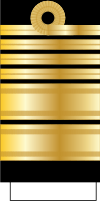 |
 |
| 元帥海軍大将 (Gensui-kaigun-taishō) |
Fleet/Marshall/Grand Admiral (Admiral of the fleet) (The title used for some Admirals with achievements) |
 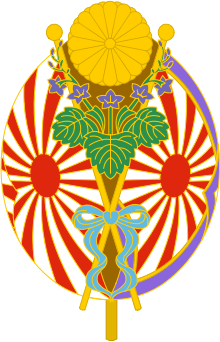 (Same insignia as admiral; with enamelled breast badge) |
 | |
| 海軍大将 (Kaigun-taishō) |
Admiral |  |
 | |
| 海軍中将 (Kaigun-chūjō) |
Vice-admiral | 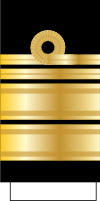 |
 | |
| 海軍少将 (Kaigun-shōshō) |
Rear-admiral | 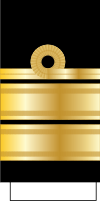 |
 | |
| 海軍大佐 (Kaigun-daisa) |
Captain | 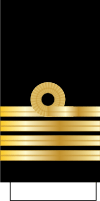 |
 | |
| 海軍中佐 (Kaigun-chūsa) |
Commander |  |
 | |
| 海軍少佐 (Kaigun-shōsa) |
Lieutenant-commander |  |
 | |
| 海軍大尉 (Kaigun-dai-i) |
Lieutenant |  (Three buttons were added before 1942 for the Special Duty Officer) |
 | |
| 海軍中尉 (Kaigun-chūi) |
Sub-lieutenant (Lieutenant junior grade) |
 (Three buttons were added before 1942 for the Special Duty Officer) |
 | |
| 海軍少尉 (Kaigun-shōi) |
Ensign |  (Three buttons were added before 1942 for the Special Duty Officer) |
 | |
Cadet and warrant officer ranks
Midshipman and warrant officer's collar insignia is same (both were treated as officer-equivalent), but in detail, midshipman's position is above warrant officer. Cadet is much likely to be classified as non-commissioned officer, since the cap's line is only one, compared to the commissioned officer's cap which has two lines and the type 3 uniform is based on the enlisted personnel.
| All-forces ranks | English translation | IJN insignia (sleeve) | IJN insignia (collar & shoulder boards) |
|---|---|---|---|
| 海軍少尉候補生 (Kaigun-shōi-kōhosei) |
Midshipman | .png) |
 |
| 海軍予備学生・生徒 (Kaigun-yobi-gakusei/seito) 海軍見習尉官 |
Officer candidate | ||
| 兵曹長 (Heisōchō) |
Warrant Officer | Three buttons were on before 1942.
No sleeve insignia after 1942. |
 |
| 海軍兵学校生徒 (Kaigun-heigakō-seito) 海軍委託生 |
Cadet |  |
-collar.svg.png) |
Non-commissioned officer and enlisted personnel rates
For seamen and petty officers, which were selected from enlisted men or conscripts and given one year of training in the Navy PO Academy, the names were different from the army names but were equal in rank. Different service branches within the navy had their specialization augment the common rank name. For example, Imperial Japanese Navy Air Service had "Flight" (飛行) incorporated into the common rank name, such as Flight Petty Officer First Class (一等飛行兵曹) or Flight Seaman Second Class (二等飛行兵).[2] For practical use, these rank names were often shortened to 一飛曹 or 二飛, respectively. The enlisted rank insignia and names were updated on 1 November 1942.[2] See the table below for details:[1]
| All-forces ranks | IJN insignia (upper sleeve) after 1 November 1942 | |||
|---|---|---|---|---|
| Before 1 November 1942 | After 1 November 1942 | |||
| Rank | English translation | Rank | English translation | |
| Petty officers 下士官 (Kashikan) | ||||
| 一等兵曹 (Ittōheisō) |
Petty officer first class | 上等兵曹 (Jōtōheisō) |
Chief petty officer |  |
| 二等兵曹 (Nitōheisō) |
Petty officer second class | 一等兵曹 (Ittōheisō) |
Petty officer first class |  |
| 三等兵曹 (Santōheisō) |
Petty officer third class | 二等兵曹 (Nitōheisō) |
Petty officer second class |  |
| Enlisted/Seamen 水兵 (Suihei) | ||||
| 一等水兵 (Ittōsuihei) |
Seaman first class | 水兵長 (Suiheichō) |
Leading seaman |  |
| 二等水兵 (Nitōsuihei) |
Seaman second class | 上等水兵 (Jōtōsuihei) (senior seaman) |
Able seaman |  |
| 三等水兵 (Santōsuihei) |
Seaman third class | 一等水兵 (Ittōsuihei) (seaman first class) |
Ordinary seaman |  |
| 四等水兵 (Yontōsuihei) |
Seaman (seaman fourth class) |
二等水兵 (Nitōsuihei) (seaman second class) |
Seaman recruit |  |
Service branch colors
The branch of the Navy in which non-executive personnel served was indicated by a color code. For officers, including midshipmen, it was the color of cloth placed as background to the cuff stripes, on both sides of the gold lace on the shoulder boards, and as longitudinal piping on the collar patches. Midshipmen and cadets wore a colored anchor on the cap, which cadets wore on the shoulder boards as well.[1] The branch of enlisted men was denoted by the color of the Chrysanthemum flower on their rank patch; line personnel using the default gold.
| Color | Branch |
|---|---|
| Violet | Engineering |
| Brown | Ship and engine construction |
| Purple-brown | Ordnance construction |
| Red | Medical |
| Pale green | Legal |
| White | Paymaster |
| Black | Survey officers |
| Light blue | Aviation (Imperial Japanese Navy Air Service) and Hydrography |
| Green | Chief carpenters (warrant officer) |
| Grey-blue | Band master (warrant officer) |
See also
- Army ranks of the Japanese Empire during World War II
- Comparative military ranks
- Military of Japan
- Military rank
References
- Rosignoli, Guido (1980). Naval and Marine Badges and Insignia of World War 2. Blandford Colour Series. Link House, West Street, Poole, Dorset, BH15 1LL: Blandford Press Ltd. pp. 152–153.CS1 maint: location (link)
- Lundstrom, John B. (2005b). First Team and the Guadalcanal Campaign: Naval Fighter Combat from August to November 1942 (New ed.). Annapolis, Maryland: Naval Institute Press. ISBN 1-59114-472-8.

